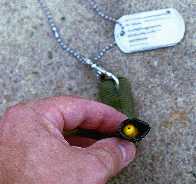The Case for Combat Ear Plugs: Good Things Come in Small Packages

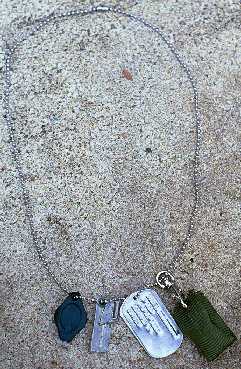
Private "Dizzy" Flores in civilian attire; every well-dressed trooper doesn't leave the barracks without combat ear plugs...
New Soft EPC with SERE items on chain
By the eXtreme Soldiering Combat Light Working Group (ESCL-WG)
Michael Sparks, Brian Heitman, Kevin, Aston, Eric Graves, Brian Bascomb, Ken Nelson, Carlton Meyer, Ralph Zumbro, Phil West, Chris Louviere, Nick Minecci, Keith Kacmar, Zach Hughes

Most of us have realized that the current plastic cases for ear plugs are dysfunctional: they are too large and clumsy; you don't even want them in your pocket attached to your key chain! They do make great holders for survival balls of cotton dipped in vaseline to start campfires stored in a larger SERE kit, but that's another story. The end result of these unwieldy cases is that ear plugs are NOT on every Soldier's person at all times and every training exercise where hearing protection is needed, parachute jumps, weapons firing etc. a box of disposable ear plugs is broken out and handed out and used/discarded. What the troops are not "hearing about" is that hearing loss is one of the most damaging disabilities in DoD, and I'm certain its because ear plugs are not on everyone's person in a reliable, unobtrusive way such that they get used.
What some Army units do is require that the current obnoxious ear plug case be chained to the front of the BDU/ACU top so we all can look like jackasses. Aside from looking stupid, its a tactical liability just asking to snag on something like a "wait-a-minute" vine and voila! There you are again, no ear plugs and after awhile no hearing. I don't know about you, but I enjoy my hearing and do not relish wearing a hearing aid or standing in long lines at the VA. However, the sad truth is that the mandarins at VA who think tax dollars for vets are THEIR MONEY do not pay disability compensation for hearing loss during military service, since ear plugs are "issued" and "mandatory." (ie: they have an excuse to hog the money up for themselves). The authors know a friend whose hearing has decreased sharply since 2000. He will receive nothing for it, even though he always wears ear plugs. Cheap bastards!
We must have a better ear plug case for the better ear plugs.
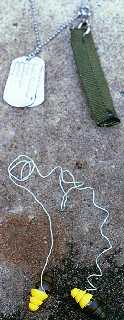
So one day, I took some 1 and 3/4 inch OD tubular nylon--the kind you use to cover the drinking tube of your Camel-Bak--and discovered it makes into a very small, soft case for the new Combat Ear Plugs being fielded which have two wear options--yellow side out for complete noise blockage and green side out for blockage of weapons firing but allows for tactical sounds like possible enemy movement to be heard. You take a Type III 550 parachute cord inner strand and tie each end to the center stem of each plug and fuse with a flame to seal the knot. Now both ear plugs are "dummy corded" to deter loss when worn.
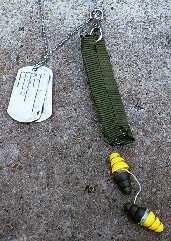
You cut a 4" length of tubular nylon and heat fuse each end. Next, you heat a nail and poke a hole 1/4" down from each end in the center. Snap a mini-link through one of the tubular nylon end holes. Roll up your ear plugs' dummy cord and insert them into the open end of the tubular nylon. Once inside, bend the nylon tube in the middle and hook the end hole onto the mini-link. You now have a SOFT, very small ear plug case!
Brian Heitman improved on this idea by sewing one end together and using velcro to close the other and keep the two ends together so it can wrap around the BDU Rigger's or web belt for inconspicuous wear. The new EPC can also be attached to the M3A Corporal Desmond T. Doss Combat LifeSaver Assault Pack's shoulder strap slots. Details of his EPC are described in his power point presentation below:
Alternate Ear Plug Case Carry Mode
The pay-off is that you can now clip this on to your ID "Dog Tag" chain around your neck or on your BDU belt and its small size and softness will not make it noticeable; ie: now you will have your ear plugs with you ready-to-use!
Of course, I did it the "homemade" way and its not really refined. All we need is a web gear manufacturer to SEW one end of the tubular nylon shut and nicely melt holes in perfect circles, sew the ends, add velcro etc. and mass-produce the soft ear plug cases for G.I.s to buy for less than $1 and a major problem will be solved!. Soldiers will not have to look like jackasses with large ear plug cases dangling visibly from their BDUs to verify that they have hearing protection: commanders can simply have them show their ear plugs when they show their dog tags on their neck chains. The winner in all of this is everyone: commanders have Soldiers who do not become combat inneffective from ear damage, Soldiers retain their hearing and Congress and the tax payers save money so it can be used to buy the upgrades we need for our M113A3 Gavin infantry-carrying light tanks so we can airdrop, and stealthfully outmaneuver via band-tracks and hybrid-electric drives; crushing our enemies with 30mm autocannon, Javelin missile and dismounting infantry weapons fires.
We tentatively call the new EPC the "Private Roger Young Ear Plug case" since he was a Congressional Medal of Honor (CMH) winner who had hearing impairment yet fought valiantly despite of it. (Details below)
If you agree that we need a new ear plug case please contact the New Combat Arms Ear Plug; NSN 6515-01-466-2710, Combat developer and tell her your ideas:
LTC Lorraine Babeu PHD
(410) 278-4152
lbabeu@arl.army.mil
New Combat Ear Plug Details:
http://botachtactical.com/aearcomarear.html
Other Options...
Another excellent pair of combat ear plugs comes from Surefire; they have an extra level of protection for when operating around machinery or shooting guns. They are extremely comfortable and conform to the shape of wearer's ear. They are also easy to dummy-cord because of the conformal ear frame offering easy attachment for cords.
www.surefire.com/EP3-Sonic-Defenders

About Private Rodger Young, U.S. Army National Guard:
 www.youtube.com/watch?v=1MEJM0cboDg
www.youtube.com/watch?v=1MEJM0cboDg
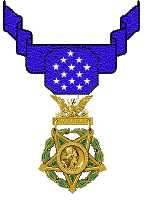

Color photos: www.homeofheroes.com/photos/index_2.html
Young, Rodger W., Private, 148th Infantry, 37th Infantry Division (the Ohio Buckeyes); born Tiffin Ohio, 28 April 1918; died 31 July 1943, On the island New Georgia, Solomons, South Pacific, while single-handedly attacking and destroying an enemy machine-gun pillbox. His platoon had been pinned down by intense fire from this pillbox; Private Young was wounded in the first burst. He crawled toward the Pillbox, was wounded a second time but continued to advance, firing his rifle as he did so. He closed on the pillbox, attacked and destroyed it with hand grenades, but in so doing he was wounded a third time and killed.
His bold and gallant action in the face of overwhelming odds enabled his teammates to escape without loss; he was awarded posthumously the Medal of Honor.
His Story by J. C. LeGere (former) Sergeant, Airborne Infantry
http://dwrighsr.tripod.com/heinlein/ryoung.html
freebootrr@aol.com
July 31, 2000 will mark 57 years since the day Pvt. Rodger Young was killed in action. His Medal of Honor citation is a public record, but it's pretty terse.
Here are some other things I've learned about him.
Rodger Young was a small man.
He grew up in the kind of blue-collar Midwestern town for which -- then and now -- high school sports is the heart of the community. But he was too light for the football team and too short to be a threat in basketball. He is said to have had a strong, accurate arm as a baseball infielder, though, which later served him well. In any case, he was a tough, enthusiastic competitor.
In a basketball game he was fouled and, with his legs knocked from under him, he hit the court head-on. He was struck unconscious but revived later in a hospital, apparently unharmed. Today, with better gadgets and more knowledge, it might have been clear that he had suffered some neurological damage.
Soon, he began to complain of deteriorating eyesight and hearing.
His parents got him eyeglasses, but he still began to flounder in school, having trouble seeing the blackboard or following what was being said. He dropped out and went to work in a factory, then, to bring in a little more cash, he signed up for the Ohio National Guard.
It seems strange now that they would have taken a boy with obvious vision and hearing problems. But it was only part-time soldiering in a peace-time Guard and Young probably did his best to conceal his problems. Perhaps the examining physician was incompetent, indifferent or just sympathetic to a kid who needed the money. After Pearl Harbor, when the Guard was federalized, Young was suddenly a real Soldier in a real war and perhaps he was grandfathered in on the strength of his previous exam.
In 1942 the 148th Infantry Regiment, with the other elements of the 37th Division (Ohio National Guard) were sent by train to Fort Shelby, Mississisppi, for training. There, Pvt Young's enthusiasm again seemed to eclipse his physical limitations. He was promoted to staff sergeant and, when his outfit departed San Francisco the following spring aboard the SS President Coolidge, bound for Fiji, he was the proud leader of a rifle squad.
Much of the account so far I have drawn from a book for young people by Rick Sowash called Heroes of Ohio: 23 True Tales of Courage and Character (1998), which I hereby gratefully acknowledge.
It's further described and available for purchase here:
Also, see Mr. Sowash's site at . In addition to being a writer/historian/folklorist/humorist, Mr Sowash is a noted and accomplished classical composer.
I am looking at a photograph of Rodger Young reproduced in that book, probably taken shortly before he shipped out. He looks back, in his class-A uniform with saucer-cap and traditional ill-fitting collar, with a round, boyish face and soft eyes behind GI-issue steel-frame spectacles. He looks amazingly like the actor Gary Burghoff in his role as the immortal Cpl. "Radar" O'Reilly of the 4077th MASH.
In 1943, the 37th Division was shoveled into the Southwest Pacific campaign, about which a few words:
The Pacific theater of operations was so vast, the hundreds of places where Americans and Japanese fought so remote and obscure, that it must have been difficult even then to follow what was happening. Today's graduates, I am told, have great difficulty connecting the phrase "World War II" with anything at all. Most of the seniors recently polled at some of our elite colleges couldn't say whether General MacArthur or General Washington comanded at Yorktown. Sic Transit Gloria Mundi.
For those who care, let us recall that between December 1941 and June 1942, the Japanese gained sway over most of the western and southwestern Pacific. In the spring and summer of 1942 the United States Navy stopped their advance in two places: at the Battle of the Coral Sea, just north of Australia, and at Midway in the central Pacific, just west of Hawaii. Now began the effort to recapture what they had taken and were determined to keep.
The extreme southeastern corner of the Japanese defense perimeter was anchored by the island of Guadalcanal in the Solomon Islands group, northeast of Australia. In August 1942, Admiral Halsey delivered General Vandegrift and ten thousand U. S. marines to Guadalcanal in the first major amphibious operation of the [Pacific] war. Their objective was to capture and hold an airfield, an item of immense strategic value for which the usual price had to be paid.
The struggle for Guadalcanal went on for six months, on the island and in the adjacent seas, and it was fighting of almost unimaginable ferocity. The order to "fight to the last man" is sometimes heard in military history, but seldom obeyed. In the case of Guadalcanal, however, and a hundred other places, the Americans found that to prevail they must, almost literally, kill every Japanese soldier who could hold a rifle. The Japanese took no prisoners, and we took very few. One thousand seven-hundred fifty-two Americans died to capture Guadalcanal. When the island was pronounced secure in February it contained 24,000 dead Japanese soldiers.
Eventually, Army troops were landed to relieve the battered and decimated marines. When the 37th Division arrived in 1943, fighting was over. But the things they saw and heard must have provided a grim foretaste of what was to come. The boys from Ohio were slated to take the next airfield on the next island in the Solomon chain, just to the northwest: New Georgia, where there were thousands more Japanese troops, dug-in and ready.
To continue with the next, and final chapter of Rodger Young's short life I shall quote at length from an account by Stanley A. Frankel.
This wasn't written by an academic historian, but by a Soldier who was there, one of Rodger Young's comrades of the 148th Infantry Regiment, 37th Division (Ohio National Guard), then commanding a platoon in D Company.
Stanley Frankel was a graduate of Northwestern University, who had spent his college years writing fiery anti-war editorials in the student newspaper and taking the Oxford (i.e., pacifist) Oath.
He was drafted into the still-peacetime National Guard in 1940 (as could happen then), and successively promoted and OCS'd, finishing the war as a major commanding an infantry battalion.
The 148th Regiment soldiered on through the Pacific campaigns after New Georgia. They bled again at Bougainville, and were prominent in the re-capture of Manila in the spring of 1945, for which they received a Distinguished Unit Citation.
Mr Frankel had a distinguished post-war career as a writer, businessman, television producer and college teacher, most notably as a speechwriter for such liberal eminences as Adlai Stevenson, Hubert Humphrey, and Robert Kennedy. But the honor he particularly relished was being included on President Richard Nixon's infamous "enemies list."
Mr Frankel died two years ago in New York, at the age of 80.
One of then-Lieutenant Frankel's "extra" duties on New Georgia, on the strength of his college writing background, was to assist the regimental staff in drafting letters to next-of-kin, recommendations for decorations, and such, where, perhaps, it was thought that a bit of polished prose would be helpful. The following account was apparently given to him in that capacity, related soon after the action by Pvt. Young's Platoon Leader and his surviving comrades.
I have edited this somewhat for length, hoping that the Major wouldn't mind.
....For more than 45 years, the approach of July 31 has caused me nightmares of jungle combat, a queasy stomach, and a drifting away of my concentration . . .
Rodger Young died on a little island called New Georgia. He died in such a way that he was awarded a posthumous Medal of Honor and was chosen from among many heroes to be immortalized in a song of the infantry.
It should be enough to record that Rodger Young died a hero... Yet perhaps only a half dozen of us know the real and complete story of his quiet gallantry.
It began on a humid day on Guadalcanal in June 1943. The 148th Infantry Regiment, Young's outfit, was girding for its next objective-- New Georgia Island with its insignificant but strategically vital Munda airstrip.
The company commander was busy that morning. He looked up sharply when Rodger Young, a thin, pale, and bespectacled staff sergeant, walked into his tent, saluted and said: "Sir, I would like to request permission to be reduced to the rank of private." It was an odd request. "What is your reason for wanting to be busted, Sergeant?" the captain asked brusquely. "Well, sir--" The little sergeant reddened, and continued haltingly, "well, you see, my ears are going bad. I can't hear very well any more." He swallowed, and then finished in a rush. "And I don't want any of my men killed in New Georgia because of me."
The C. O. 's eyes narrowed suspiciously. Was this a new twist in the technique of getting invalided home? "What's the matter, Sergeant?" he barked. "Don't you want to fight?"
Young stiffened. "Sir," he said distinctly, "I don't want to leave the outfit. I want to go on -- but as a private, so I'm only responsible for myself. I don't want to get anyone hurt because of me." His voice was thin and firm. "If I thought I'd be left behind because of this, then I'd rather drop the whole thing."
He half sold the captain, and an hour later the company doctor confirmed Young's story. The sergeant's ears were in bad shape. "Shall we send him to the field hospital?" the doctor asked. "No!" Rodger Young answered emphatically.
The doctor shrugged and the captain made a gruff apology. He promised to get Sergeant Young reduced to the rank of private "without prejudice," which he did the next day.
Three weeks later, the 148th Regiment (along with the rest of the 37th Division,) invaded New Georgia. The jungle was an almost impenetrable wall of vines and tangled undergrowth. The insects were unbearable, the food miserable, the water supply inadequate. At night, the 148th dug foxholes in mud and limestone. And, of course, there was always the enemy.
One evening the tropic sun took its sudden plummet into blackness just as 15 Soldiers staggered into the company lines. Among them they carried five bodies, wrapped in blood- stained shelter halves. The lieutenant in charge of the ragged platoon made his report to the captain.
That morning, he had taken 20 men on a reconnaissance patrol a mile in front of the lines. He had led his men along an old, seemingly deserted Japanese trail, overgrown with vines and bushes. After a futile search for signs of enemy activity, he turned back at 4 o'clock, intending to be in his own company area before dusk.
As they trudged along the gloomy trail, the Japanese machine gun opened up suddenly and killed two men before the platoon could flatten into cover. The gun was fiendishly placed on high ground, commanding the entire area. There was no way around it; to rush it meant sudden death.
The lieutenant attempted a mass maneuver with his remaining 18 men, and two more died.
The situation was critical. If they could not break out of the trap before nightfall, the Japanese would move in. With the machine gun cutting off the only possible avenue of escape, the enemy was in no hurry.
.... What went on behind Young's spectacles and between his rather deaf ears no one knows. What is known is that he began to inch forward, cradling his rifle in his arms, past the lieutenant and toward the machine-gun nest.
The lieutenant saw him slither by, and tried to grab his leg. But Young was in a hurry and evaded his superior's grasp. Furthermore, the Japanese saw the rustle of grass and loosed a burst that singed the lieutenant's hand and tore his collar.
"Come back here!" the lieutenant screamed at Young. "It's suicide. Come back-- that's an order!"
Young hesitated a moment, then twisted his head around and grinned at the lieutenant. "I'm sorry, sir," he said, "but you know I don't hear very well."
He turned then, and continued to snake his way toward the Japanese emplacement. They saw him coming, of course. A stuttering burst cracked into Young's left arm and splintered the stock of his rifle.
Young let the useless weapon drop. Still, he pressed forward. His buddies fired blindly at the emplacement, trying to divert the spitting stream of death. It didn't work.
Another burst of fire sewed a scarlet seam down Young's left leg, from thigh to ankle. But he kept going, and finally reached a shallow hole about five yards from the machine gun. It was deep enough to afford him rather tenuous safety as the Japanese apparently couldn't depress the muzzle of their gun far enough to get a clean shot at him.
"For God's sake, Young," the lieutenant shouted, "stay where you are! We'll get you out somehow."
Maybe that time Private Young really didn't hear. He might have been dying at that moment. In any case, he wasn't in the mood for playing possum.
Painfully, he reached into his belt with his good right hand for a grenade. He pulled the pin with his teeth. Then, rearing up and back-- up out of his position of relative safety-- he lobbed the grenade toward the machine gun.
The gun answered with a blast that caught him full in the face. Rodger Young died as the grenade left his hand. Still, well thrown, it lit in the center of the machine-gun crew -- and killed every one of the five Japanese manning the weapon.
.... the 15 survivors were on their interrupted way back to Company D. Silently they carried their five dead. Rodger Young didn't need to worry any more about being responsible for the lives of his buddies.
Two weeks later, the sweltering little island was in American hands... Company D's captain composed a lengthy recommendation that Private Rodger Young be awarded the Medal of Honor. One sentence read:
"Disregarding the orders of his platoon leader to come back, Rodger Young moved forward into the face of enemy fire." The regimental commander changed that to "Not hearing the orders..." No one; in his regiment disobeyed orders, he remarked acidly.
The company commander also wrote letters to the next of kin of those in his unit who had been killed, including, of course, to the parents of Rodger Young. A month later, Rodger's mother replied, thanking the captain for his note, commenting that Rodger's bravery made the loss of an only son a bit easier to bear, and asked for a small favor: "Rodger was proud of being a staff sergeant. Since his body won't be returned to us until after the War, we would like to put up a little monument in our Clyde, Ohio, cemetery, and would it be permissible to write 'Staff Sgt. Rodger Young' on the tombstone?"
The captain quickly put in a request to Division Headquarters, asking that Private Rodger Young be promoted posthumously back to staff sergeant. He recounted the original reason for the demotion, the posthumous Medal of Honor, and attached the request from Rodger's mother. The Army remained inflexible. The request was denied; a number of Army regulations were cited justifying the turndown, and when the captain protested in a personal visit to Division Headquarters, he was told firmly that there was no appeal.
Furious . . . whipped . . . he had to write to Mrs. Young that "for the time being, your wonderful son would have to remain a private."
But this bitter rejection turned into an amazing benefit. Most of the branches of the military service had songs, but the infantry did not. The War Department assigned songwriter Frank Loesser...to write a piece for the infantry . . . suggesting he read the Medals of Honor citations for inspiration, and instructing him that he must only focus on infantry privates . . . not sergeants . . . not officers . . . but privates!
Frank Loesser sought out the single most dramatic action by a doughboy-private. The Rodger Young story was shown him and he had to read it only once.
A military citation is a strange place in which to find inspiration for a ballad. But from just such a dispassionate source sprang the moving ballad of Rodger Young. ...
The complete text of Mr Frankel's memoir, Frankel-ly Speaking: About World War II in the Pacific (1992) is available online at: www.frankel-y.com is worth reading. He is also the author of "The 37th Division: The Buckeye Division, which I have not consulted. Available here:
PAPERBACK:
www.amazon.com/exec/obidos/ASIN/1563112191/qid%3D964664843/103-0583 629-4885407
Pvt (formerly: Staff Sergeant) Rodger Young was brought home to Ohio.
Anyone who pases near the small town of Clyde and wants to visit will find his gravestone in the McPherson Cemetery, at the intersection of Routes 20 and 101. Clyde is just south of Sandusky, about midway between Cleveland and Toledo.
Sergeant Frank Loesser was a Soldier assigned to the USO. He had written songs for Hollywood and Broadway, but was still essentially unknown outside his profession. Postwar, he would prosper as the writer of one of the classic American musicals: "Guys and Dolls."
Loesser cranked out several tunes for the Army, "Praise the Lord and Pass the Ammunition," was probably the best known. He had a knack for producing slightly wry lyrics that deferred to the unsentimental GIs, while still pleasing his bosses among Army publicists. As a march, "The Ballad of Rodger Young," hasn't matched the popularity of the Air Corps' "Wild Blue Yonder," or the Artillery's "Caissons" (the latter having been adapted for the whole Army). Perhaps being the commemoration of an individual soldier rather than an institution didn't commend it to the brass, or perhaps it was its unwelcome reminder that Soldiers die, and disutility as a recruitment tool. But it is all the more more effective for those reasons.
Whether Robert Heinlein first heard of Young from war-time press accounts, or from Loesser's song, I can't say.
Heinlein first mentions Rodger Young in his 1949 story "The Last Watch," in which, facing his own death, Lt. Johnny Dahlquist reflects that:
"He was not alone; there were comrades with him -- the boy with his finger in the dike, Colonel Bowie, too ill to move, but insisting that he be carried across the line, the dying captain of the Chesapeake still with deathless challenge on his lips, Rodger Young, peering into the gloom."
When Heinlein composed his novel, Starship Troopers in 1958, he intended that, among other things, it would be a tribute to the infantry Soldier, and "The Ballad of Rodger Young" is its theme song, quoted several times in the story.
Heinlein, however, chose to snip a line from one part of the song and splice it to another. Whether this was inadvertant or deliberate we can't say. I suspect he just preferred the sound and sense of the re-arranged couplet, despite, or perhaps because of, the foregone rhyme (which might keep it from looking/sounding a bit too Tin Pan Alley-ish in print). Call it a Frank Loesser-Robert Heinlein collaboration. I don't think either the Sergeant or the Lieutenant would mind:
"To the everlasting glory of the Infantry, Shines the name, shines the name of Rodger Young..."
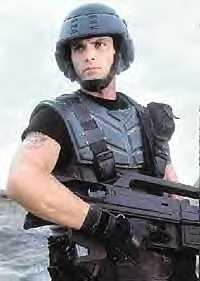
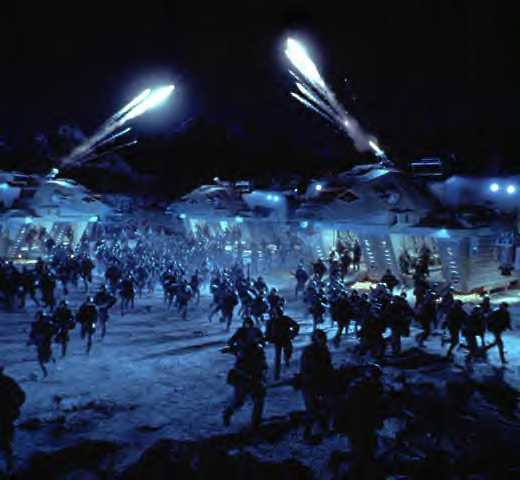
For author Robert Heinlein, Rodger Young stood for that noblest of men--the Soldier willing to put himself in harm's way for the sake of his people. Heinlein first mentions Young in 1952, when he recorded his piece for Edward R. Murrow's "This I Believe" show. Heinlein expands greatly on the theme in 1958 with "Starship Troopers", a controversial novel which he freely admits having written in part to "glorify the military...specifically the P.B.I., the Poor Bloody Infantry, the mudfoot who places his frail body between his loved home and war's desolation--but is rarely appreciated." In the story, Johnny Rico serves aboard the troopship Rodger Young, and we have occasion to hear the boarding tocsin for that ship, a verse from Frank Loesser's "The Ballad of Rodger Young":
"To the everlasting glory of the infantry...Shines the name, shines the name of Rodger Young"
Entire Song:
SLOW, VERY SAD
www.west-point.org/users/usma1981/38405/west_point/songs/RodgerYoung.htm
"The Ballad of Rodger Young,"
No, they've got no time for glory in the Infantry.
No, they've got no use for praises loudly sung,
But in every Soldier's heart in all the Infantry
Shines the name, shines the name of Rodger Young.
Shines the name--Rodger Young!
Fought and died for the men he marched among.
To the everlasting glory of the Infantry
Lives the story of Private Rodger Young.
Caught in ambush lay a company of riflemen--
Just grenades against machine guns in the gloom--
Caught in ambush till this one of twenty riflemen
Volunteered, volunteered to meet his doom.
Volunteered, Rodger Young!
Fought and died for the men he marched among.
In the everlasting annals of the Infantry
Glows the last deed of Private Rodger Young.
It was he who drew the fire of the enemy
That a company of men might live to fight;
And before the deadly fire of the enemy
Stood the man, stood the man we hail tonight.
On the island of New Georgia in the Solomons,
Stands a simple wooden cross alone to tell
That beneath the silent coral of the Solomons,
Sleeps a man, sleeps a man remembered well.
Sleeps a man, Rodger Young,
Fought and died for the men he marched among.
In the everlasting spirit of the Infantry
Breathes the spirit of Private Rodger Young.
No, they've got no time for glory in the Infantry,
No, they've got no use for praises loudly sung,
But in every Soldier's heart in all the Infantry
Shines the name, shines the name of Rodger Young.
Shines the name--Rodger Young!
Fought and died for the men he marched among.
To the everlasting glory of the Infantry
Lives the story of Private Rodger Young.
---Frank Loesser
 "If there's no more DADT, then I want co-ed shower operations immediately. I have some bug juice to wash off my body. Click on my picture for details."
"If there's no more DADT, then I want co-ed shower operations immediately. I have some bug juice to wash off my body. Click on my picture for details."
What do YOU think, Trooper?

